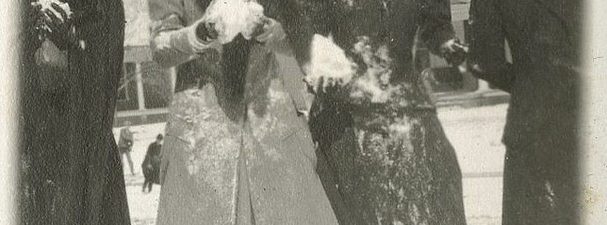
by Joseph Lipham, Student Assistant
As the chilling winter winds approach Baylor’s campus and the ominous cloud of finals looms near, so does one of Baylor’s most beloved traditions. Christmas on 5th Street ushers in the jolliness of Christmas right in the heart of the Baylor campus. While students are away spending Thanksgiving with their families, the campus is adorned with oversized candy canes, ornaments and as many Christmas decorations as one could possibly imagine. Returning home from Thanksgiving to find their campus completely remodeled into a Winter Wonderland, it is no wonder why this is every student’s favorite time of the year.
These traditions takes place on 5th Street, the central street on campus that runs by the Student Union Building (SUB) and Fountain Mall. Taking place on November 30 the every year, Christmas on 5th kicks off the winter holiday. A variety of activities are set up at Fountain Mall, including a petting zoo filled with animals and “Santa’s Workshop.” There’s even a life-sized Nativity scene set up in front of the SUB. While these activities take place throughout the entirety of the day, the most exciting and event begins roughly around 8:15 P.M each year.

The annual Kappa Omega Tau Christmas Tree Lighting has begun around the same time each year, since it began in 1965. The annual tree lighting is an opportunity to bring Baylor students and faculty together to bask in the bright lights of the ginormous tree. Housed in the center of Burleson Quadrangle, the large Christmas tree is decorated by Kappa Omega Tau and the Department of Student Activities. The tree is adorned with bright white lights and red bows. Accompanying these festive decorations are presents at the base of the tree, donated by Baylor students for children in need.
Christmas on 5th even brings snow to Central Texas; in Vera Daniel Plaza, a snow machine is set up to give students a true Winter Wonderland experience. While the weather may be chilly, and the threat of finals may loom near, Christmas on 5th pulls out nearly all the stops to warm the hearts of all Baylor students and instill the spirit of Christmas into every person who engages in the activities strewn throughout Baylor’s campus.
This year, the festivities will begin at 5:30pm on November 30th. For more information about this event, please visit this website.
If you are an alum who has photographs or materials related to the Christmas Tree Lighting and are interested in sharing these with The Texas Collection, please contact our University Archivist, Leanna Barcelona.






![Mission San Antonio de Valero [The Alamo] by Donald Yena](https://farm5.staticflickr.com/4447/38093854391_b4f16473aa_o.jpg)
![Armstrong, Yvonne M. Black Trailblazers of San Antonio, Texas: Their Businesses, Communities, Institutions and Organizations. San Antonio: Inkbiyvonne, [2006]. Print.](https://farm5.staticflickr.com/4473/38041078916_203bf506f6_o.jpg)
![The Majestic Hotel and Bath House Co. [Marlin, Texas?]: [publisher not identified], [between 1908 and 1920?]. Print.](https://farm5.staticflickr.com/4486/26317334539_6cca6730c7_o.jpg)
![Jordan, E. P. Souvenir of Austin, Texas. Brooklyn, N.Y. : Albertype Company, [1907]. Print.](https://farm5.staticflickr.com/4506/37384595144_12a70af086_o.jpg)